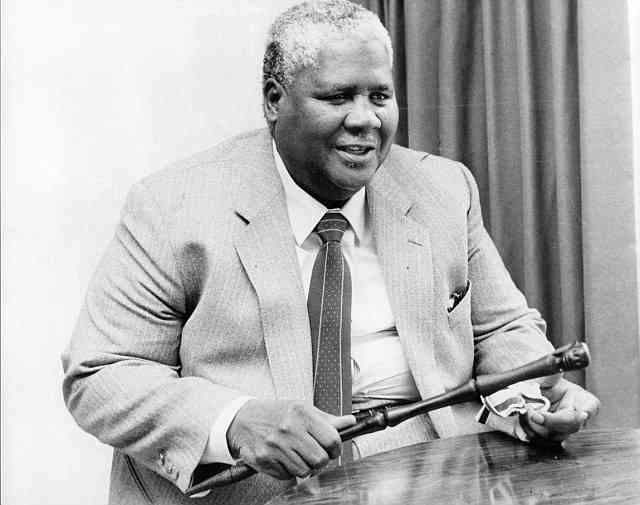
THE reader may ask the question: When does superstition become religious or when does religion become superstitious?
Some dictionary meanings of the word superstition seem to indicate that religion and superstition belong together.
The Oxford Universal Dictionary, in one of its definitions, says that superstition “is unreasoning awe or fear of something unknown, mysterious or imaginary, especially in connexion with religion” or “ an irrational religious belief or practice”.
So I always wonder when Ndebele people talk about umkhobo or ukuloya, umuntu acuphe unyawo lwakho — inhlabathi lapho onyathele khona ayoyisebenza ubusufinyela unyawo. When you express doubt you are told: “Yisayensi yabantu leyo.”
Can you apply to it the definition “an irrational religious belief or practice?” Science can be observed and proved, so if it is “yisayensi yabantu”, can anybody scoop earth (soil) with someone’s footprint and work on it with “medicine” for other people to observe and prove it?
It would be interesting if someone brought an umkhobo to a science laboratory for observation.
Some people (izinyanga, izanuse, izangoma) claim to have the power to exorcise imikhobo and other evil spirits and that if you are interested they will smear or touch or sprinkle certain “medicines” round your eyes and only then can you see them.
The same mystery surrounds the belief in ghosts. Some people will swear that they have actually seen a real ghost in their life experience.
- Chamisa under fire over US$120K donation
- Mavhunga puts DeMbare into Chibuku quarterfinals
- Pension funds bet on Cabora Bassa oilfields
- Councils defy govt fire tender directive
Keep Reading
The superstitious or religious explanation for the existence of umkhobo is that when a person dies and is buried, wizards/witches come to dig up the grave at night and take out the body which they carry to their hut or some unknown hideout.
They then perform some magical ceremony and by way of spiritual incantation call back the spirit of the deceased who eventually comes back to life, that is, soul and body reunite to become a new living being.
The body is mysteriously collapsed together to a short rather bulky structure, but looking more human than beast. If it is male, it will be bearded with red glossy eyes.
Its tongue is cut off so that it will not speak distinctly. It can walk, run and jump as these are necessary in the performance of its master’s nefarious duties.
By the use of certain charms it is rendered invisible. It is incapable of doing or rendering good service. It is active almost only at night to beat up people, steal, administer harmful “medicines” on sleeping victims and so on. When someone suffers a stroke, utshaywe yimkhobo.
One is amazed how many people actually believe this fiction. This creature is also referred to as imfakabili because it eventually dies (a second death) and there is no indication of its final destination.
Sometimes religion is not only funny, it is silly really and, as indicated in the quoted definition above, it is “irrational”. The Ndebele believe in ukuloya which is the use of harmful magic to hurt other people.
This magic is said to work on the intended victim sometimes without any physical contact, ukuphosa. You live, say in Nqameni and the person that you aim at is at Siphepha in Tsholotsho.
Somehow you capture his shadow (uthatha isithunzi sakhe) and you work on it magically by mixing certain “medicinal” portions and take a little creature (say a toad) to represent the victim.
You now shout the name of the victim vigorously stirring the mixture of your “medicines” and you prayerfully invoke the spirits of your ancestors to descend on the victim with all the vengeance.
You take a big thorn and stab the toad and say: “Yiya Mlingo! Fana lobubi bakho!” As you perform this process, wena useNqameni khonale, poor Mlingo gets a sudden attack of isihlalo and within a day he is gone.
There are certain practices that are done within a family home that have a religious significance. A man’s kraal can be protected from evil spirits and wizards by what is known as ukubethela isikhonkwane.
That means that certain “medicines” (protective herbs) are sprinkled round the homestead and others buried at the corners. Yizo izikhonkwane lezo.
When this has been done by a hired inyanga, no wizard has the power to enter the homestead at night. If a witch does enter, she will be found standing still near a hut, stark naked and unable to move until and unless the head of the family strikes her with a switch (uswazi).
Another practice is to designate a bull from the herd, usually a black one and conduct a small, but important ceremony to make it the idlozi lekhaya.
All worship of the family is conducted in the presence of this bull. Whenever a worship (thethela) ceremony is being conducted and the bull urinates then the ancestors are happy and have accepted the request that was being made by the family.
This bull becomes recognised as the symbol of the family unit and family health. It must not be ill-treated or disturbed in any way lest you invite the wrath of the ancestors.
This same honour may be bestowed upon a chosen goat instead. Some other goat may be chosen “to wash out bad luck or illness” in the family.
After performing a special ceremony upon it, the goat is taken to the bush away from an inhabited areas and there it is let loose to be devoured by jackals.
If anybody tampers with it, the bad luck that was washed onto it is immediately transferred upon him. Fact or fiction?
Think of a witch (umthakathi) riding upon a small animal , like an 88kg woman riding upon a 42kg antbear for 5km. The antbear is said to trot at a high speed of 15km per hour. It may be a hyena that is being ridden.
One cannot easily reconcile the facts of this event.
Of course, there is much more to say about superstition and fiction. What is being said applies in various forms to all (and all means all) religions.










